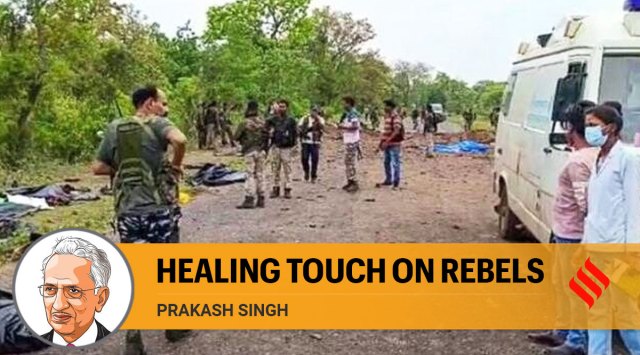
The ambush of the convoy in which 10 personnel of the District Reserve Guards (DRG) and their civilian driver were killed on April 26 in Chhattisgarh’s Dantewada district shows that the Maoists retain the capacity to launch lethal attacks on security forces.
The Home Minister has been giving the impression that the end of the Maoist problem is near. On January 7, while addressing a public meeting in Korba, Chhattisgarh, Amit Shah said that the government’s efforts are on “to ensure that the entire country is free from the Naxal problem by 2024”. In 2019, he had said that the Naxals will be buried 20 feet under the ground. In fact in 2010, then Home Minister P Chidambaram had said that “the Centre was confident of overcoming the ultra-left problem in the next three years”.
The security forces have been gradually extending their domination over areas hitherto under Naxal control. According to the Home Ministry’s data, fatalities inflicted on civilians and security forces by left-wing extremists fell below 100 in 2022, the lowest in four decades, even as the security forces established 175 new camps since 2011 in traditional Naxal strongholds. Security forces, however, can deliver up to a point. They can take care of the law and order aspect of the problem. The Maoist problem is multi-dimensional; it has social and economic aspects. Unless the problem is tackled in its entirety, it is unlikely to go away.
We should remember that in the past century, the government had twice come to the erroneous conclusion that the Naxal problem had been sorted out. The first time was after the arrest of Charu Majumdar in 1972 followed by his death and schism in the party. The movement, however, revived in 1980 with the formation of the People’s War Group. It again disintegrated in the mid-nineties when Kondapalli Seetharamaiah was arrested and operations by the police and central paramilitary led to the arrests and surrender of almost 10,000 party activists.
The movement had another resurrection in 2001 when the Naxals formed the People’s Liberation Guerrilla Army (PLGA). The central task of the party was the “seizure of political power”. The movement attained its acme in a few years. In 2009, then-Prime Minister Manmohan Singh described it as “the gravest internal security threat to our country”. Since then the movement has been on a decline with considerable attrition in CPI(Maoist) leadership also. The confidence (or the over-confidence) of successive Home Ministers should be seen in this context. Perhaps they are right. Or they would be proven wrong again. There is no room for complacency.
There are two fundamental flaws in our anti-Naxal strategy. First, in most states, there is a tendency to outsource the operations against Naxals to the central armed police forces. The states must realise that unless the local police, who know the language and terrain, take the lead in anti-Naxal operations, the problem would linger. In Punjab, the battle against terrorism could be won because, apart from other factors, the Punjab Police was always at the forefront of operations. Second, as pointed out by an Expert group of the Planning Commission (of which the author was also a member) in 2008, “the development paradigm pursued since independence has always been ‘imposed’ on the tribal communities and has been insensitive to their needs and concerns”. As a result, government plans have “ended up in destroying their social organisation, cultural identity, and resource base and generated multiple conflicts.” The tribals want schools and hospitals, but they neither need nor want capital-intensive plants or factories, which are inevitably accompanied by deforestation and displacement.
There is no overall strategic plan against the Naxals. States have been carrying out anti-Naxal drives according to their individual understanding. Territorial domination is essential and security forces are able to achieve that, but that should be followed by the administrative apparatus establishing its network in the affected areas. Moreover, a conscious effort must be made to win the hearts and minds of the people.
The government should seriously think of applying the healing touch. If it can have peace talks with the Nagas and several other insurgent outfits in the Northeast, there is no reason why it should not take the initiative to have a dialogue with the Maoist leadership. This would not be seen as a sign of weakness — on the contrary, it would be taken as a magnanimous gesture.
Singh, former Director General of BSF, is author of The Naxalite Movement in India